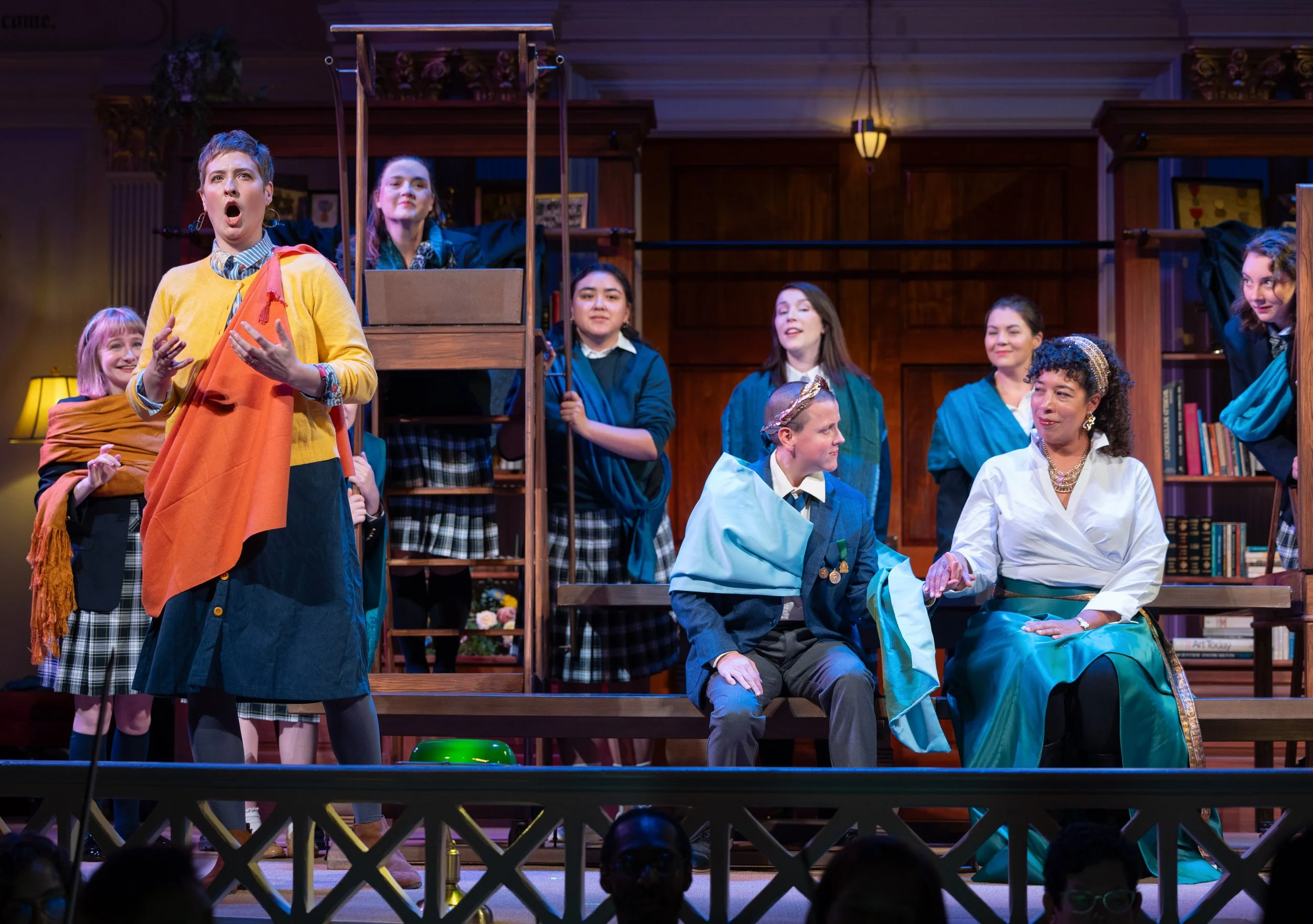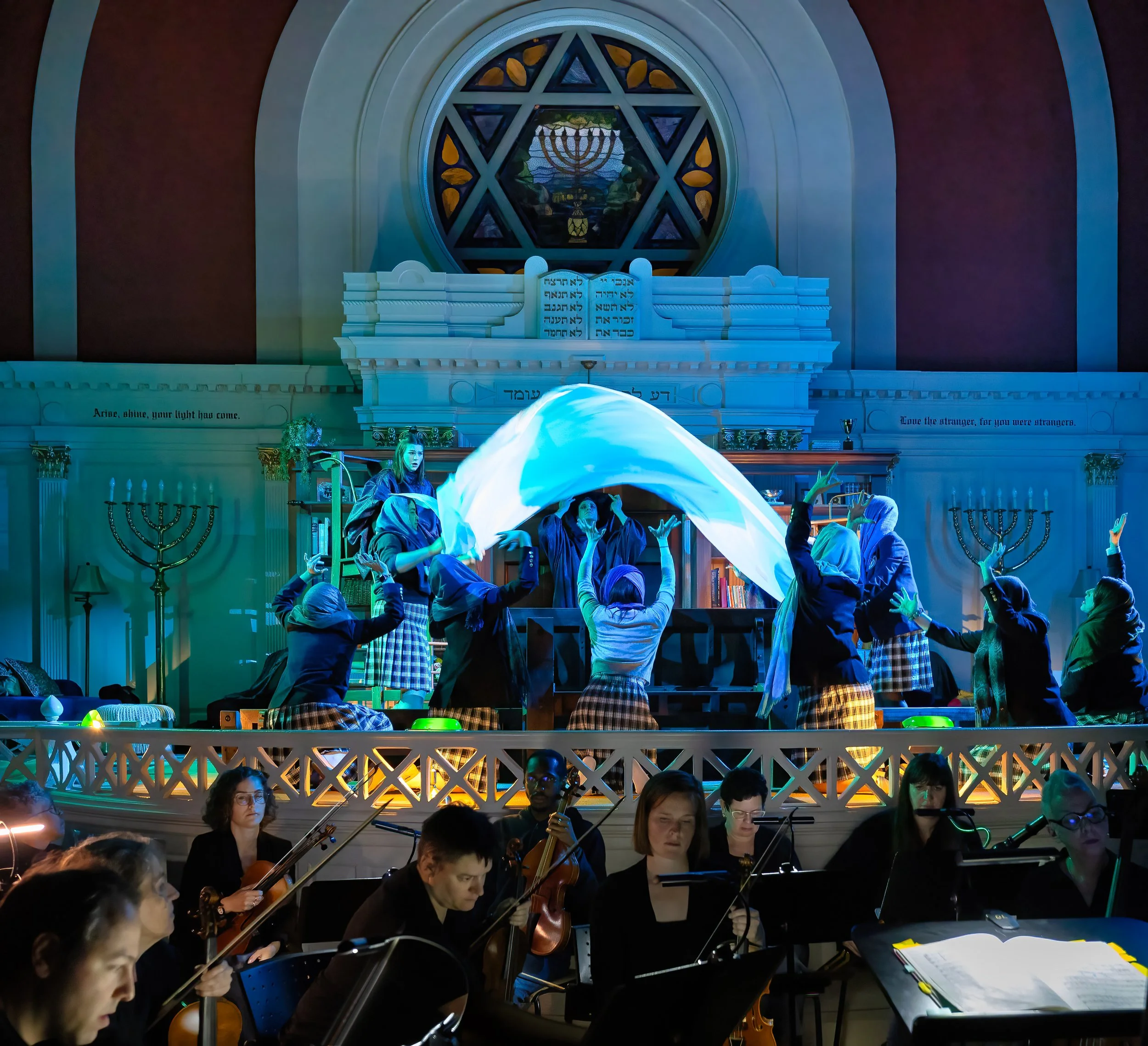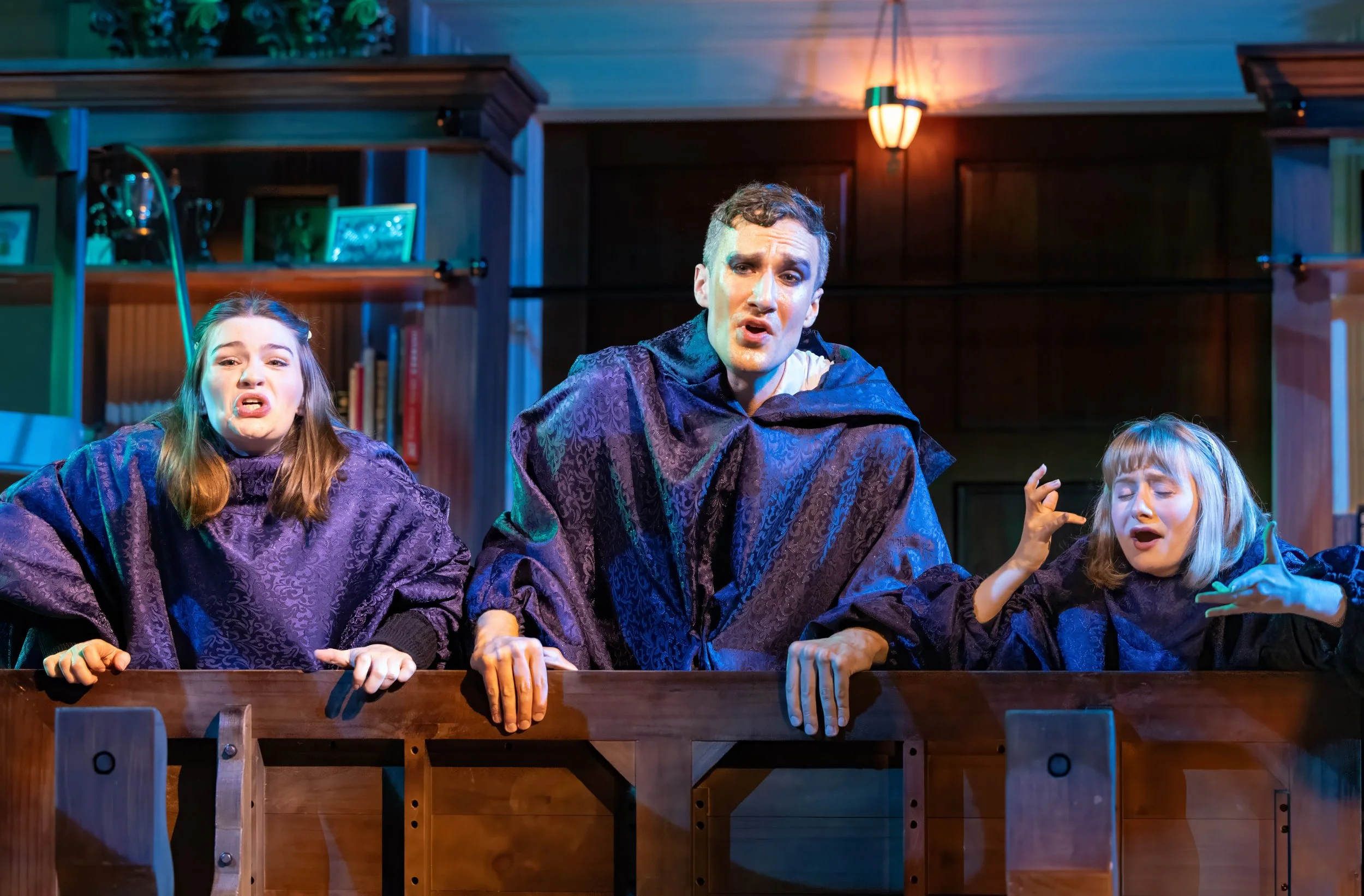Under new leadership, in a new venue, Opera Lafayette has done it again, breathing new life into a classic work of centuries yore, in a performance that was entertaining, enlightening, authentic, and culturally enriching, while exhibiting charm and delight with its creativity and performance artistry. With Purcell’s Dido and Aeneas (1689), his first production as Artistic Director, Patrick Quigley has scored another hit for the company, continuing its mission while adding touches of his own. In his words, this season “extends the legacy of founder Ryan Brown, who established this company as a rare home for French Baroque opera in America. That legacy of scholarship and excellence endures, coupled with a wry twist, pairing historical accuracy with a knowing wink.” Dido is French Baroque opera, you question? We’ll deal with that later.
Belinda (Chelsea Helm, center left) listens to her friend Dido (Mary Elizabeth Williams, center right) while the students look on. Photos by Jennifer Packard Photography, courtesy of Opera Lafayette.
Composer Henry Purcell (1659-1695) is credited with putting English classical music back on the map after the English Civil War and the decline of court music; he has had a significant influence on composers after him. Amazingly, he only composed one complete opera, that being Dido and Aeneas, yet that opera is said to be the first great British opera! The opera was important in enhancing his connection to theater and future employment. Semi-operas came after with additional great music. The story of his full opera from a life that only lasted 36 years gets even better. Historical evidence suggests it was first performed by amateurs in the Chelsea boarding school for girls in London in 1689. However, its exact history is uncertain and has been the subject of debate among music historians. An original manuscript of the score was never found, and the current opera has been pieced together from different sources holding parts of the score. There is a historical copy of the libretto by Nahum Tate (1652-1715), who used as source material his play Brutus of Alba and Virgil’s Aeneid; Mr. Tate later became Poet Laureate of England.
Belinda (Chelsea Helm, front left) sings as Aeneas (Elijah McCormack, front center) and Dido (Mary Elizabeth Williams) experience their bonding. Photos by Jennifer Packard Photography, courtesy of Opera Lafayette.
In the opera, Dido, Queen of Carthage, has fallen in love with the Trojan hero Aeneas; he has been shipwrecked in Carthage on his journey to fulfill his destiny of founding Rome. He declares his love for her, and they plan to be together. However, a sorceress and her coven of witches devise a plan to have an impostor appear as Mercury and tell Aeneas that the gods insist he must continue that night on his journey. He plans to depart Carthage, and upon learning of his decision, Dido is distraught. He claims he will stay with her, but her heart is broken, telling him that he must go and she must die. He leaves and she sings a now-famous aria lament. While Virgil emphasizes Aeneas duty to serve the gods and found Rome, librettist Tate uses demonic forces to bring about the tragedy, a popular theme in English theater of the day; remember the witches in Shakespeare’s Macbeth. While author Virgil focuses on duty and honor, librettist Tate bends the drama towards the power of fate and lessons of love.
The coven of witches celebrate the arrival of the Sorceress. Photos by Jennifer Packard Photography, courtesy of Opera Lafayette.
Ok, the French baroque opera connection: Purcell’s score for Dido and Aeneas was significantly influenced by Italian and French opera of the times, particularly the inclusion of dance and a focus on tragedy found in the operas of Lully in Paris; nevertheless, Dido is substantially English with its choral elements and libretto in English. Nahum’s poetry in the libretto reminded me of Shakespeare. Some examples:
The sorceress and the coven state their purpose -
“…what's thy will?
Harm's our delight and mischief all our skill.”
As Dido dies, the Cupids gather -
“With drooping wings ye Cupids come,
And scatter roses o'er her tomb,
Soft and gentle as her heart;
Keep here your watch, and never part.”
First Witch (Cecelia McKinley, left), Sorceress (Hans Tashjian, center), and Second Witch (Kayleigh Sprouse, right) plat Dido’s destruction. Photos by Jennifer Packard Photography, courtesy of Opera Lafayette.
The opera is concise, telling the story in just over an hour, as the mood of each scene changes. The music, the singing, the dancing, all play important roles in telling the story; there are recitatives and arias, but no spoken dialog. The inclusion of dance may have been influenced by the boarding school’s founder and director, Josias Priest, a choreographer at Theatre Royal. Opera Lafayette has removed the action from mythological times and placed it in the boarding school, complete with the young women in training and their mentors who act out the story, the story of Dido, within the story of the opera’s first performance. Impressively, each element was excellently executed, and it worked as a whole! Despite the absurdity of the story, I felt sad for Dido as she died of a broken heart, ending our enchanting evening together.
The role of Dido was played by international soprano Mary Elizabeth Williams, an inspired choice. She appeared previously with Opera Lafayette in OL’s world premiere of Morgiane. Her range and her command are amazing; her voice was always imbued with the emotion the words express, a truly compelling Dido and schoolmistress. As I sat there, I felt that listening to her sing was like being bathed in roses. Her accomplices all served their roles well. Her friend and a mistress at the school was Belinda, sung beautifully by soprano Chelsea Helm. She communicated genuine concern for Dido, a compassionate counterpoint to the emotional Dido. Playing the roles of Second Woman and spirit was soprano Kayleigh Sprouse, who has an attention-garnering voice, adding delight to this production. Aeneas was played by male soprano Elijah McCormick, who was rather stiff, officious, and sang beautifully. The Sorceress was sung by bass-baritone Hans Tashjian who also played a Sailor. As Sorceress, he made a Halloween-worthy entrance. Mr. Tashjian is a large man who is imposing in a large dark cloak. He sings very well, but his voice and nature were more playful than frightening. Contralto Cecelia McKinley added appealing dramatic depth as Second Woman, First Witch.
Dido (Mary Elizabeth Williams) ascends to her death as Belinda (Chelsea Helm) observes. Photos by Jennifer Packard Photography, courtesy of Opera Lafayette.
Director Quigley led an eighteen-piece ensemble expertly in producing Purcell’s beautiful Baroque music. The music began delightfully and contributed to the mood and action in each scene; it’s easy to see why this is called a great opera. Always with Opera Lafayette, authenticity is the key; the music is played on period instruments that included a harpsichord, contrabass, and theorbo. The program notes reveal that OL’s production delivered the music “as is” without adding to or deleting from the accepted score. The Opera Lafayette Chorus, led by Director Quigley, also plays a substantial role in Dido and Aeneas, not only singing but playing supporting roles from school girls to witches to spirits and others. The chorus consisted of seven female singers: Annabelle Welford-Small, Kyeugeun Lee, Mary Wright, Matilda Smolij, Susan Kravinski, Charlotte Stewart, and Elizabeth Barnes. Vocal music is a specialty of Director Quigley. He comes to OL after 24 years as Founder and Artistic Director of the Miami vocal group, Seraphic Fire. For more insight into his plans for Opera Lafayette, I recommend critic Charles Downy’s excellent interview with him in the Washington Classical Review.
Artistic Director Patrick conducting the Opera Lafayette Orchestra. Photos by Jennifer Packard Photography, courtesy of Opera Lafayette.
The small stage at the Sixth and I Historic Synagogue served very well for this opera, and Opera Lafayette made the most of it with stage design by Lisa Schlenker, costumes by Lynly Saunders, and Lighting by Christopher Brusberg. The stage design allowed the cast to move around the props as scenes changed, and the costumes with the girls in school uniforms seemed perfect. There were even some special effects with lighting, well done by all. The staging was well and effectively executed by Connie Hayes, adding dramatic and comic effects while moving around quite a few players in the constrained area during dance numbers. Well done, delightful!
Opera Lafayette has a record of inventiveness that is astounding when I look back on the many performances I have attended. OL has ventured outside France on a number of occasions in the past, such as placing an opéra comique in a Colorado barn; OL gave the first-ever performance of an opera written in 1887 and has often engaged in collaborations with dance companies and even a pop fashion designer. Mr. Quigley has begun by moving the ball forward. He concludes his program notes with the following statement on this season’s offerings: “Each program holds scholarship in one hand and playfulness in the other.” Bring it on.
The Fan Experience: Performances of Dido and Aeneas were scheduled for October 16 and 18 in the Sixth and I, DC and for October 20 in EL Museo del Barrio, NYC. The opera is sung in English with English supertitles shown overhead. The opera lasts 70 minutes. The performances were close to sellouts. Ticket prices varied from $35 to $110, and some of the balcony seats have restricted view.
An informative pre-opera talk is given by Professor Amanda Eubanks Winkler one hour before the performance, dealing with the history of the opera and its first performance in a boarding school for girls. Director Quigley roamed the audience with a microphone to allow a few questions after the talk.
Venue photo. Photos by Jennifer Packard Photography, courtesy of Opera Lafayette.
Sixth and I, while suitable and adequate for the performance, as a venue poses some challenges for attendees. Some things to consider, I took the subway from Tysons Corner and walked two blocks from the Gallery Place subway stop to the theater, rather than engage downtown DC traffic and locating a parking spot close to the theater; there are parking garages around the venue. Coming out of the theater, we exited on the side of the building, not the front where we entered. Though the tickets have seat numbers, the seating is by section; you can sit at any vacant spot in your section, another reason to get there early and hear the pre-opera talk. All of this is spelled out on the Opera Lafayette website. I got there early and was seated in the center. From there, I was close to the orchestra which was seated below the stage, and the acoustics were excellent. Going in with the early crowd, I did not notice any stands offering snacks or drinks.







